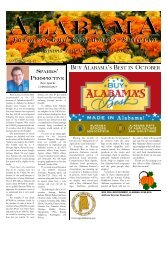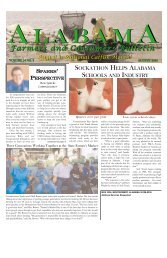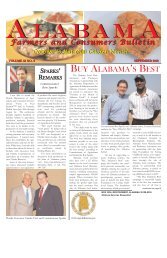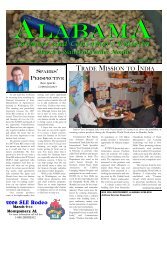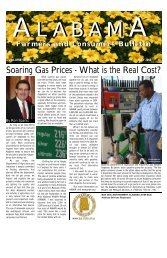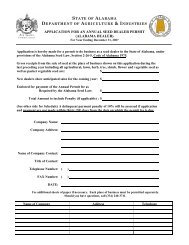Lessons Learned from Rural Schools - Alabama Department of ...
Lessons Learned from Rural Schools - Alabama Department of ...
Lessons Learned from Rural Schools - Alabama Department of ...
You also want an ePaper? Increase the reach of your titles
YUMPU automatically turns print PDFs into web optimized ePapers that Google loves.
LLS-0010 <strong>Lessons</strong> <strong>Learned</strong>_Pub.qrk: 4/25/09 3:02 PM Page 6<br />
6<br />
Where Tomorrows Begin<br />
Aperfect storm–fueled by the out migration <strong>of</strong><br />
young adults and rising poverty and strengthened<br />
by a declining economy and loss <strong>of</strong> jobs–swirls<br />
across rural <strong>Alabama</strong>.<br />
In its wake lie communities struggling not only to maintain<br />
a certain standard <strong>of</strong> living, but just to exist. And the<br />
most notable victims are the smallest among us, the children.<br />
Nowhere does this show up as starkly as visiting a school<br />
lunchroom. Here you find that six out <strong>of</strong> ten students in<br />
<strong>Alabama</strong>’s rural public schools are receiving either free or<br />
reduced meals. And for these six, school is <strong>of</strong>ten a challenge<br />
as data <strong>from</strong> the <strong>Alabama</strong> <strong>Department</strong> <strong>of</strong> Education<br />
shows that they trail non-poverty students significantly<br />
in reading and math scores.<br />
Too <strong>of</strong>ten these students are not on a path to a cap and<br />
gown, but to never going to school after their 16th birthday.<br />
The fact that rural schools have only 30 percent <strong>of</strong><br />
the students in <strong>Alabama</strong>, but 36 percent <strong>of</strong> the dropouts, is<br />
testimony to this.<br />
<strong>Rural</strong> <strong>Alabama</strong> didn’t get to this juncture overnight; it’s<br />
been on this road for years. Ten years ago 54.2 percent <strong>of</strong><br />
rural students were free-reduced lunch, now 61.9 percent<br />
are. Ten years ago there were 60 rural schools with 90 percent<br />
or more <strong>of</strong> their students on free-reduced meals, now<br />
there are 78. There are 31 schools in <strong>Alabama</strong> where less<br />
than 10 percent <strong>of</strong> the students are on free-reduced<br />
lunches, none <strong>of</strong> them in rural communities.<br />
But we <strong>of</strong>ten fail to pay adequate attention to the big<br />
picture. Instead, we form commissions and study groups<br />
and hold meetings. And too <strong>of</strong>ten, rather than looking for<br />
where the blood is coming <strong>from</strong>, we look for band-aids.<br />
Truth is; the blood is coming <strong>from</strong> a lot <strong>of</strong> places; <strong>from</strong><br />
lack <strong>of</strong> decent jobs, <strong>from</strong> lack <strong>of</strong> a diversified economy,<br />
<strong>from</strong> lack <strong>of</strong> a qualified workforce, <strong>from</strong> lack <strong>of</strong> infrastructure.<br />
But most <strong>of</strong> all, it is coming <strong>from</strong> our children, <strong>from</strong> the<br />
circumstances that hobble their education in both the<br />
home and school.<br />
And if we’re to weather this storm, all <strong>of</strong> us concerned<br />
about the future <strong>of</strong> rural <strong>Alabama</strong>, every legislator, every<br />
mayor, every county commissioner, every bank president,<br />
every mama and daddy, every business owner, must begin<br />
where every tomorrow begins—with our children.<br />
<strong>Lessons</strong> <strong>Learned</strong> <strong>from</strong> County <strong>Schools</strong> is an honest attempt to<br />
shed light on one <strong>of</strong> <strong>Alabama</strong>’s most pressing needs—how<br />
do we better prepare the 30 percent <strong>of</strong> the state’s children<br />
who go to public school in rural communities for a future<br />
where a quality education will be the rule and not the exception?<br />
The remaining pages <strong>of</strong> this publication explain what<br />
was learned about 10 outstanding rural schools and 10<br />
communities that are sprinkled across rural <strong>Alabama</strong> <strong>from</strong><br />
near the Gulf Coast to the Tennessee Valley. They <strong>of</strong>fer<br />
glimpses <strong>of</strong> what is possible when expectations, teamwork,<br />
collaboration and pride become a way <strong>of</strong> life.<br />
But to fully understand these schools and communities,<br />
it is first necessary to understand the challenges they face.<br />
The section, The Reality <strong>of</strong> Being <strong>Rural</strong>, provides the<br />
backdrop and context <strong>of</strong> why rural schools face a different<br />
set <strong>of</strong> circumstances than schools in either suburban or<br />
inner city locations.<br />
In Education is more than pencils and paper we<br />
look at the “external environment” <strong>of</strong> these schools. What<br />
are the intangibles that both community and school administration<br />
and teachers bring to the education process?<br />
• We learned there is a culture <strong>of</strong> expectations on each<br />
school campus. Whether it is by having a parade, a Pride<br />
Assembly or celebrating your Native American heritage,<br />
schools work hard to make students feel special and instill<br />
a willingness to achieve.<br />
• <strong>Schools</strong> build trust with the community and parents. As<br />
former principal Betty Warren says, “…the parents must<br />
know you love their babies. If they know this, they will<br />
support you.” <strong>Schools</strong> also work hard to interact with their<br />
communities.<br />
• Each <strong>of</strong> these schools is a clean, neat and attractive facility.<br />
None <strong>of</strong> these schools are new, but they are all bright,<br />
cheerful and welcoming. In case after case, principals told<br />
stories <strong>of</strong> going the extra mile to paint, clean windows and<br />
landscape buildings and grounds.<br />
• There is definitely a sense <strong>of</strong> family on all 10 campuses.<br />
Principals go out <strong>of</strong> their way to make everyone <strong>from</strong><br />
teachers to custodians to bus drivers to lunchroom workers<br />
feel appreciated and a key part <strong>of</strong> the educational process.<br />
In the section, What happens when the bell rings?<br />
we examine the “internal environment” dealing with how<br />
administrators manage and motivate, how students are<br />
motivated and school culture.<br />
• One <strong>of</strong> the key findings was that nine out <strong>of</strong> 10 princi-<br />
The Center For <strong>Rural</strong> <strong>Alabama</strong> • (334) 240-7272



